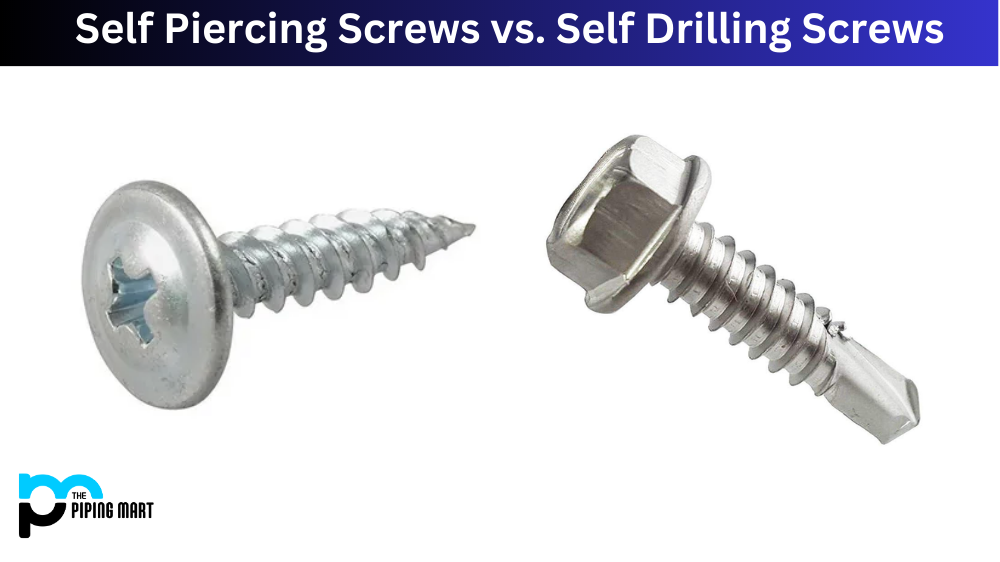Self Piercing Screws vs Self Drilling Screws – What’s the Difference
| 2:51 pm


If you’re into construction or DIY projects, you’re probably familiar with the importance of having the correct type of screw for your project. Two types of screws that can be particularly useful are self-piercing screws and self-drilling screws. While they may seem similar initially, their application and efficacy differ significantly. In this blog post, we’ll explore the battle between self-piercing screws vs self-drilling screws and which one comes out on top.
Self-piercing Screws
Self-piercing screws are designed to penetrate through materials and create a tightly secured connection between two surfaces. They do not require any pre-drilling or pre-punching, making them a popular choice for DIY enthusiasts who want a quick and easy solution to their projects. These types of screws work particularly well for softer materials such as aluminium, plastic, and thin sheet metal. Because they pierce materials rather than drill them, they offer a cleaner, more aesthetically pleasing finish.
Self-drilling Screws
On the other hand, self-drilling screws are designed to create pilot holes as they’re screwed into the material. This makes them particularly useful for more complex materials such as wood, sheet metal, and plastics. Self-drilling screws also tend to be stronger and more durable than self-piercing screws. They can withstand shear forces better and are less likely to strip or come loose over time. They may require more effort to install, resulting in a more secure connection that will last longer.
Which One is Better?
When it comes to choosing between self-piercing screws and self-drilling screws, there are a few factors to consider. Firstly, what materials will you be working with? Self-piercing screws work better with softer materials while self-drilling screws are designed to work with more rigid fabrics. Secondly, what type of finish do you want? If aesthetics are important, self-piercing screws may be the way to go. Finally, what level of strength and durability do you need? If you want a long-lasting, secure connection, self-drilling screws may be better.
Difference Between Self-piercing Screws and Self-drilling Screws
- Self-piercing screws are designed to pierce through materials without a pilot hole, while self-drilling screws are designed to drill their pilot holes as they are driven into the fabric.
- Self-piercing screws are typically made from harder metals, such as stainless steel, making them more wear and tear-resistant. Self-drilling screws are usually made from softer metals, such as aluminium, which makes them more susceptible to wear and tear.
- Self-piercing screws are typically used in applications where a pilot hole is not desired, such as when attaching metal sheets. Self-drilling screws are usually used in applications with a desired pilot hole, such as when connecting wood boards.
- Self-piercing screws typically have a sharper point than self-drilling screws, which makes them better suited for piercing through more rigid materials. Self-drilling screws usually have a duller point than self-piercing screws, which makes them better suited for drilling through softer materials.
- Self-piercing screws can be more challenging to drive into materials than self-drilling screws, requiring more force to pierce through the material. Self-drilling screws can be easier to go into materials than self-piercing screws, as they drill their pilot holes and do not require as much force to penetrate the fabric.
- Self-piercing screws can be more likely to strip out the material they are being driven into than self-drilling screws, as they do not have a pilot hole to guide them. Self-drilling screws can be less likely to strip out the material they are being driven into than self-piercing screws, as they have a pilot hole to guide them.
- Self-piercing screws can be more likely to break during installation than self-drilling screws, as they are made from harder metals and require more force to drive into the material. Self-drilling screws can be less likely to break during installation than self-piercing screws, as they are made from softer metals and do not require as much force to drive into the material.
- Overall, self-piercing screws are better suited for applications where a pilot hole is not desired and more rigid materials must be pierced. Self-drilling screwa are better suited for applications with a desired pilot hole, and softer materials must be drilled.
Conclusion
In conclusion, the battle between self-piercing screws vs self-drilling screws isn’t a battle at all. These two types of screws serve different purposes and are better suited to other materials and applications. The key is understanding what you need from your screws and choosing accordingly. Whether you’re putting together a DIY project at home or working on a larger construction project, the suitable screws can make all the difference. So, next time you’re at the hardware store, take a moment to consider which screws will work best for your project.


Abhishek is a seasoned blogger and industry expert, sharing his insights and knowledge on various topics. With his research, Abhishek offers valuable insights and tips for professionals and enthusiasts. Follow him for expert advice on the latest trends and developments in the metal industry.